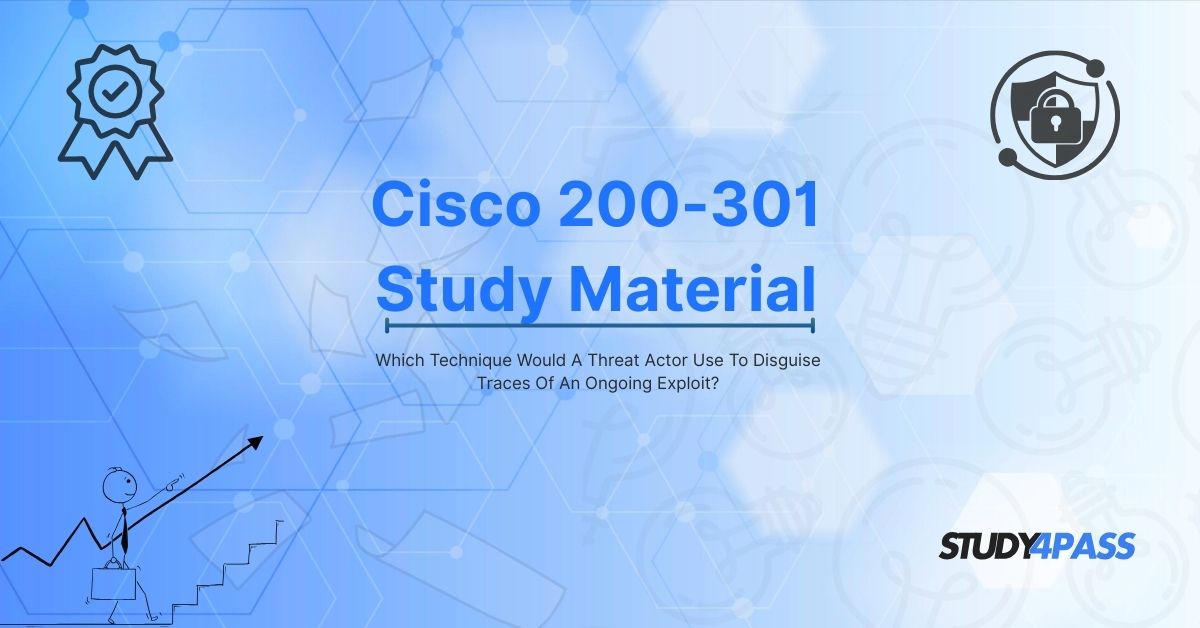Introduction to Traces Of An Ongoing Exploit
In the ever-evolving landscape of cybersecurity, threat actors continuously develop sophisticated techniques to exploit vulnerabilities while evading detection. For professionals preparing for the CCNA CyberOps Exam (200-301), understanding these concealment methods is crucial. This article explores various techniques attackers use to disguise their traces, ensuring their malicious activities remain undetected. Additionally, we highlight how Study4Pass provides the best Cisco 200-301 study materials to help aspiring cybersecurity experts master these concepts.
1. Log Tampering and Deletion
How Threat Actors Use It?
Attackers often manipulate or delete system logs to erase evidence of their intrusion. By altering logs, they prevent security teams from identifying unauthorized access or malicious activities.
Detection and Mitigation
- Centralized Logging: Storing logs on a secure, remote server prevents tampering.
- Immutable Logs: Using write-once-read-many (WORM) storage ensures logs cannot be altered.
- SIEM Solutions: Security Information and Event Management (SIEM) tools like Splunk or Cisco Stealthwatch help detect anomalies in log files.
Study4Pass Resources
Study4Pass offers in-depth Cisco 200-301 study materials covering log analysis and SIEM integration, essential for identifying log-based attacks.
2. Fileless Malware Attacks
How Threat Actors Use It?
Fileless malware operates in memory, leaving no traces on disk. Attackers leverage legitimate system tools (like PowerShell or WMI) to execute malicious scripts, making detection difficult.
Detection and Mitigation
- Behavioral Analysis: Monitoring unusual process executions.
- Memory Forensics: Tools like Volatility analyze memory exam prep practice test for malicious activity.
- Endpoint Detection and Response (EDR): Solutions like Cisco AMP detect in-memory attacks.
Study4Pass Advantage
The Study4Pass CCNA CyberOps course includes modules on memory-based attacks, helping learners understand fileless malware techniques.
3. Encryption and Obfuscation
How Threat Actors Use It?
Attackers encrypt malicious payloads or obfuscate code to bypass signature-based detection (e.g., using Base64 encoding or XOR encryption).
Detection and Mitigation
- Sandboxing: Executing suspicious files in an isolated environment.
- Heuristic Analysis: Identifying obfuscated code patterns.
- SSL/TLS Inspection: Decrypting and inspecting encrypted traffic.
Study4Pass Learning Materials
Study4Pass provides detailed lessons on encryption-based evasion techniques, crucial for the Cisco 200-301 exam.
4. Living Off the Land (LOTL)
How Threat Actors Use It?
Attackers use legitimate system tools (e.g., PsExec, Mimikatz) to avoid raising suspicion. This technique, known as Living Off the Land (LOTL), blends malicious activity with normal operations.
Detection and Mitigation
- Baseline Monitoring: Establishing normal behavior patterns.
- User Behavior Analytics (UBA): Detecting unusual command executions.
- Least Privilege Principle: Restricting unnecessary tool access.
Study4Pass Exam Prep
Study4Pass includes real-world LOTL attack scenarios in its Cisco study guide, preparing students for practical exam questions.
5. Rootkits and Kernel-Level Exploits
How Threat Actors Use It?
Rootkits embed themselves deep within the OS kernel, making them nearly invisible to traditional antivirus solutions.
Detection and Mitigation
- Secure Boot: Preventing unauthorized kernel modifications.
- Integrity Checking: Tools like Tripwire verify system file integrity.
- Hardware-Based Security: Utilizing TPM (Trusted Platform Module) for secure boot processes.
Study4Pass Training
The Study4Pass CCNA CyberOps course covers kernel-level threats, ensuring students can identify and mitigate rootkit attacks.
6. DNS Tunneling and Covert Channels
How Threat Actors Use It?
Attackers use DNS queries to exfiltrate data or maintain C2 (Command & Control) communications, bypassing traditional firewalls.
Detection and Mitigation
- DNS Filtering: Blocking malicious domains.
- Traffic Analysis: Detecting unusual DNS request patterns.
- Threat Intelligence Feeds: Using updated threat databases.
Study4Pass Study Materials
Study4Pass includes DNS tunneling detection strategies in its Cisco 200-301 exam prep, helping students tackle such questions confidently.
7. Time-Based Evasion (Sleeping Malware)
How Threat Actors Use It?
Malware may remain dormant for extended periods before activating, avoiding immediate detection.
Detection and Mitigation
- Long-Term Monitoring: Tracking processes over time.
- Heuristic Sandboxing: Running samples in extended analysis environments.
Study4Pass Advantage
Study4Pass provides case studies on time-delayed attacks, a key topic in the CCNA CyberOps exam.
Why Choose Study4Pass?
- Up-to-date Cisco 200-301 study guides
- Real-world attack simulations
- Expert-led video tutorials
- Practice exams with detailed explanations
Visit Study4Pass today and ace your CCNA CyberOps certification with confidence!
Final Words
Understanding how threat actors disguise their exploits is vital for cybersecurity professionals. The CCNA CyberOps (200-301) exam tests these concepts extensively, and Study4Pass ensures candidates are well-prepared with comprehensive study materials, practice tests, and real-world scenarios.
For the best Cisco 200-301 exam preparation, trust Study4Pass your ultimate resource for mastering cybersecurity defense techniques.
Special Discount: Offer Valid For Limited Time “Cisco 200-301 Study Guide”
Actual exam question from Cisco's 200-301 Exam Questions.
Sample Questions for Cisco 200-301 Test Prep
1. What is the primary purpose of "timestomping" in cyber attacks?
A) To encrypt files for ransom
B) To modify file timestamps to evade detection
C) To slow down system processes
D) To create backdoor access
2. Which method involves blending malicious traffic with legitimate traffic to avoid detection?
A) Rootkit Installation
B) Traffic Obfuscation
C) Brute Force Attack
D) Credential Stuffing
3. How does a threat actor use "process hollowing"?
A) By deleting system processes to crash a machine
B) By replacing legitimate process code with malicious code
C) By encrypting all running processes
D) By overloading the CPU with fake processes
4. What is "fileless malware" primarily used for?
A) Storing malicious payloads in files on disk
B) Executing malware in memory to avoid file-based detection
C) Encrypting entire hard drives
D) Spreading through USB devices
5. Which technique allows attackers to hide malicious scripts within trusted applications?
A) DNS Spoofing
B) Code Injection
C) MAC Flooding
D) ARP Poisoning


